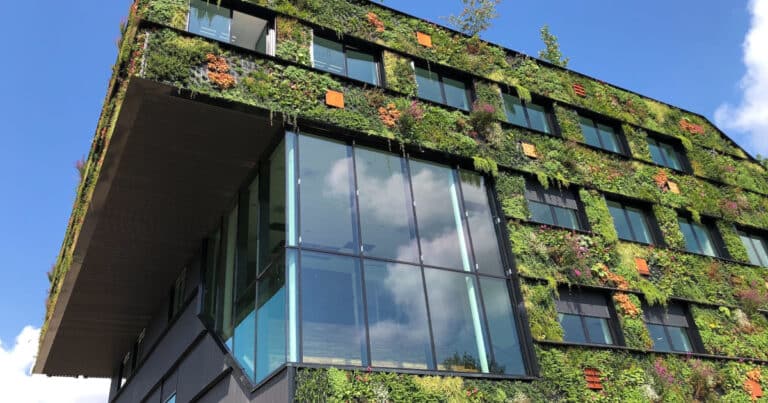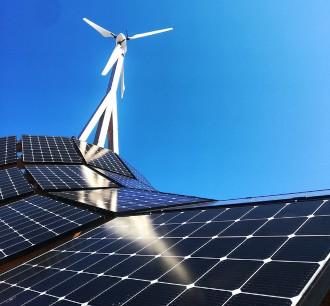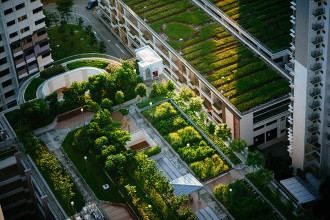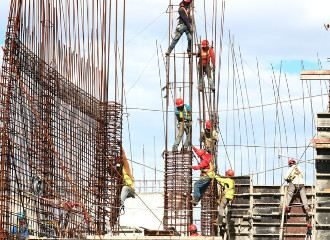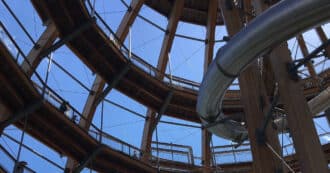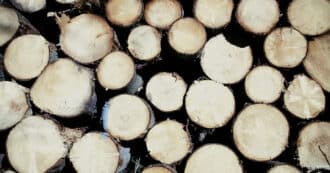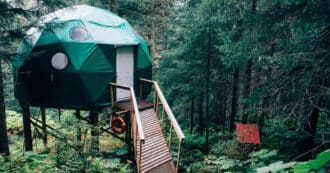By Harry Cooper – The Earth has been dominated by human activity for decades now. And as human activity and population is expanding so is our affect on the world around us.
This increase in our influence over the natural environment can primarily be seen through the spread of urbanization. Urbanization is the process of turning natural environments and ecosystems into cities, suburbs, and other places built for human activity.
This increase in the span of cities and suburbs has had some devastating impacts on the environment. Not only do cities often entail deforestation and biodiversity loss when building them, but cities themselves are often less healthy environments for the people who live there and the environment as a whole.
Urban environments put massive amounts of carbon emissions into the atmosphere which contribute to global climate change, as well as local air pollution. Along with that, darker surfaces from buildings and asphalt make cities much hotter.
A Better Way of Building Cities
All in all cities are very environmentally unfriendly places, but many are starting to challenge this. While cities may cause harm to human health and the environment, they are home to billions of people, and are not going anywhere.
This has started a growing movement to build cities more sustainably, and a big part of that is utilizing green architecture. Simply put, green architecture is a way of designing buildings with the environment in mind which could mean anything from designing buildings to be more energy efficient, or making a building with more sustainable building materials.
What ever way someone tries to make the buildings they design greener, the growing green architecture movement has sparked the idea that cities can be more than just a place for humans to live but they can also help us address environmental issues such as pollution and climate change. And as the green building movement gets more and more traction, people are discovering and inventing more and more ways to make their buildings more sustainable.
Renewable Energy and Environmental Design
One of the best green building practices, is to design them to use renewable energy. This means buildings would rely less on fossil fuels to power them, and more on energy sources such as wind and solar. Many buildings can get this renewable energy transported from large wind farms, solar farms, geothermal plants, hydroelectric dams, etc. However, since some renewable energy sources are so readily available, many buildings can harness their own renewable energy and consequently save a lot on energy costs. This tactic is also practical because it can be used also for existing buildings.
Solar Power
Installing solar panels on a building can be a great way to make buildings with a green design. Solar panels collect the energy from sunlight and convert it to usable electricity without emitting any greenhouse gases.
As long as a building has enough sunlight on it, and isn’t shaded for too much of the day, solar panels provide a building with cheap, clean, renewable energy. This saves money on heating, cooling, and lighting costs while cutting back on carbon emissions.
Wind Power
Another great way to use renewable energy in green buildings is by utilizing wind power. This can be done by installing small wind turbines on buildings.
Wind turbines can be used at a larger scale on massive wind farms to collect wind energy, but they can also be used at a smaller scale as integrated wind turbines, that can easily sit on buildings and act as an on-site power source. As long as these integrated wind turbines are placed in a consistently windy spot they can be an excellent source of renewable energy.
Green Roofs
Green roofs are another excellent method of sustainable architecture. Green roofs are a type of environmental design that involves planting miniature gardens on roofs. These types of roofs are much more efficient at regulating temperature than traditional roofs. Roofs built with conventional building materials are normally dark and absorb lots of sunlight and heat. On the other hand, green roofs naturally regulate temperatures. This not only saves energy and money for heating and cooling buildings, but it can make cities cooler over all.
Along with this, green roofs absorb carbon dioxide and other greenhouse gases. This helps mitigate local air pollution while combating global climate change.
Types of Green Roofs
Green roofs can come in all different shapes and sizes. Some green roofs contain elaborate gardens that people can freely walk around on, while other green roofs simply involve planting one or two plant species on top of a building. Green roofs can mainly be divided into intensive roofs and extensive roofs.
Intensive green roofs are typically larger and similar to traditional gardens and parks. While these green roofs require more structural support and are more expensive, they can be more complex and provide more services, such as community gardens and walking paths.
Extensive green roofs are smaller and usually contain only one or two types of hardy plants with shallow roots. This type of green roof is much simpler and requires less maintenance and is a lot cheaper.
Cool Roofs
Similar in concept to green roofs, cool roofs provide a way to cool off buildings and the city around them. While they don’t require any plants that can remove carbon from the atmosphere, cool roofs are cheaper, simpler, and easier to install than green roofs. Cool roofs work by creating a white, highly reflective surface on top of buildings. This reflects light outwards, rather than absorbing it like traditional darker roofing. This helps cool off buildings and cool off cities, much like green roofs.
Efficient Lighting
Another way that buildings can be built to be more environmentally friendly is through the use of efficient lighting. Lighting buildings uses a lot of energy, and by designing buildings with more sustainable lighting methods, we can create more sustainable cities.
LED Bulbs
Light emitting diodes, or LEDs, are a type of light bulb that emits just as much, if not more light than traditional lighting. However these types of bulbs are much more efficient. LEDs are able to to emit light while using up to 90% less energy than traditional light bulbs do. It is also estimated that they can last up to 25 times longer than a regular light bulb. Along with this, LEDs can replace almost any kind of bulb, and are becoming much cheaper to buy.
Natural Light
While LEDs are incredibly efficient bulbs, there are ways of creating lighting inside buildings which require no electricity whatsoever. By designing buildings that utilize natural lighting through strategically placed windows, buildings can spend virtually nothing on lighting costs.
Using sunlight to light buildings directly requires some creativity. It is important to think about where to place windows, so that the inside of a building can be lit comfortably throughout the day. Many architects rely on sky lights and clerestories to help make sure there is enough light everywhere in the building.
Building With Sustainable Materials
Another way that buildings can be designed more sustainably is by using more sustainable materials to build them. Traditional building materials primarily include bricks, stone, and wood. These materials require large amounts of mining and deforestation which puts a lot of strain on the natural environment. Fortunately, there are a lot of other more sustainable building materials that contractors have started to use that make for more environmentally responsible buildings.
Bamboo is one such material. Bamboo grows at an incredibly fast rate, making it easy to grow, cheap, and widely available. Bamboo does not require much deforestation to grow and it is more flexible and stronger than wood, concrete, or brick. This makes it an ideal building material, and many people have made bamboo there go to material for cabinets and flooring.
Rammed earth is another sustainable material that has been reliably utilized for construction practices for centuries. Rammed earth entails compacting chalk, dirt, gravel, and other natural materials to make a solid form. This can be used for foundations, walls, and flooring. Rammed earth is cheaper and easier to make than traditional materials, and it can even be better at insulating buildings than its concrete and brick counterparts.
Repurposed and Recycled Materials
While using new more sustainable materials can be beneficial to making more sustainable buildings, reusing old materials results in less waste, and makes for greener buildings. Many builders have started to rely on reclaimed wood to help construct buildings. This helps prevent deforestation while making good use of old wood that would otherwise wind up rotting in a landfill.
Other builders have started to use recycled steel for there projects. Steel is very easy to recycle, and reusing it can save a lot of energy and pollution. Mining and smelting new steel uses massive amounts of energy and creates a lot of greenhouse gas emissions and pollution. By using recycled steel, builders can construct sturdy buildings more sustainably.
Green Architecture and Religion
An article in the Faith and Form journal by Reverend Fletcher Harper raises a call for religious institutions to build with green architecture. Reverend Harper explains how “there remains a disconnect, and a serious one, between what religious groups say about climate change and the architecture, construction, and maintenance of religious buildings.” Reverend Harper is working to ensure that religious organizations live in sync with their values and build in environmentally sustainable ways.
Reverend Harper points out that most religions either see Earth as God’s handiwork or see the Earth itself as Divine. With this awareness we must recognize that our “buildings are embedded within something that is profoundly holy. This means that religious buildings need to be designed, built, and operated to treat nature with the respect due a sacred revelation. In their planning, construction, and operation, religious facilities must nestle themselves beautifully and functionally within their ecosystems in ways that reflect and honor their eco-locale’s own beauty and functionality.” The construction of our religious buildings is an opportunity to physically manifest our care for Creation.
* Featured image source

